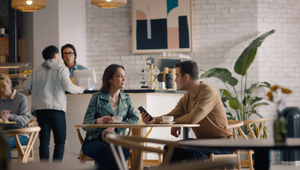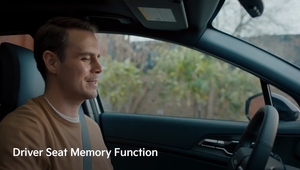
LBB Film Club: Crush

Stash Capar says his favourite projects are ones with which he holds a personal connection. Whether that’s his films about multiple sclerosis - a condition that the director was diagnosed with in 2011 - or projects involving his favourite hobbies, such as martial arts. A lifelong practitioner of kickboxing, Brazilian Jiu-Jitsu and MMA, it’s a surprise that he hasn’t combined his passions for combat sports and filmmaking until now - directing the short film ‘Crush’ for the Toronto Kickboxing and Muay Thai Academy (TKMT).
Stash has known - and even sparred with - professional Muay Thai fighter and instructor Candice Mitchell for many years - so when Candice’s business and training partner, Warren Lee, told Stash Candice’s story during a training session, the decision to make a film about her and TKMT was an easy one.
Teaming up with Chilean-Canadian director of photography Santiago Trugeda, Stash’s visually exciting and gloriously visceral film tells Candice’s story - from her youth in Trinidad and Tobago, to finding Muay Thai surprisingly late in life, subsequently competing in Thailand and her hopes of representing Canada at the Olympics in 2024. Reminding us that he is a “storyteller, not a [combat sports] pornographer,” Stash’s focus on Candice’s incredible journey avoids the “barbarism” and bloody imagery that often linchpins representations of Muay Thai in the media.
LBB’s Ben Conway caught up with the Circle Productions director to talk about how he and Santiago “knocked it out of the park” with a film that shows a different side of Muay Thai and its participants, and how they captured the essence and emotions of the sport - combining footage of “the abstract”, the present and the past.
LBB> When you first spoke with TKMT and Candice, what direction did you want to go in? And what key footage was the first thing on your shot list?
Stash> From the beginning I knew the approach wouldn’t be to follow Candice around like in a traditional doc, as logistically it would be impossible. I went for a more scripted weekend shoot where we would capture a few polished key scenes that could act as a ‘composite’ of her average day of training. On top of that, we would use archive fight footage as well as her own smartphone stuff, most of it being from her years in Thailand. This would give us two distinct timelines with two distinct looks, a polished one for the present day, and a more gritty, voyeuristic and user-generated one for the past.
I still felt like it wasn’t enough though, we needed a third texture. That’s when the idea of shooting the Wai Khru Ram Muay [a ceremonial dance performed before Muay Thai fights] came in.
LBB> And why was it important to start the film with that Wai Khru Ram Muay sequence?
Stash>I wanted to have one scene take place in an abstract, almost surreal space and the Wai Khru was perfect for that. At first, Candice wanted to do it in the ring, as per tradition, but I convinced her that the dramatic and theatrical feel of the ritual would not be lost in the abstract space, if anything, it would be accentuated.
It was a no-brainer to start the film with the ceremony as it marks the beginning of every Muay Thai fight, whether in Bangkok or Toronto or Istanbul. It also reveals small hints about the fighter’s life, lineage and fighting style which Nick (editor) drew subtle connections to, as he cut from the Wai Khru to footage of Candice crushing her opponents.

LBB> Where did you film the pads training sessions? Those scenes are quite dark with overhead lighting and generally quite close-up - what was the idea behind these shots and how did you capture them?
Stash> For a professional fighter, day-to-day training does not look like a cardio kickboxing workout where you’re being intense, running circuits and trying to break a crazy sweat on the bag. Most of the hard work is skill-building and this is done one-on-one with your coach. It’s here where current skills are sharpened and new ones are developed through endless yet mindful repetition. That really is the essence of it all - constant refinement.
The idea was to capture the spirit of this deeply focused repetition and refinement. We shot at one of the TKMT locations on a Sunday when it’s generally empty apart from private sessions. Candice showed up with both of her coaches, as well as a number of training partners, and we ran through three different skill sets that she was currently working on. The overhead lighting and haze accentuated the deep focus feeling. The idea was to create a world that is centred around the fighter and her coach, where nothing else really exists, but without going into the surreal.
LBB> What are some of your favourite shots from the film and why? Can you talk us through how you captured them?
Stash> The one that catches everyone’s eye is Candice under the highway shadowboxing, with the camera circling around her. We shot with Kowa Vintage Full Frame lenses, with the camera on a Ronin and the operator riding a Segway. It’s one of my favourite combinations of tools because of how dynamic it can be. We did long uninterrupted takes where the camera and Candice got into a sort of orbital flow.
My personal favourite shot is a more subtle one though. There’s a moment when Candice’s Muay Thai trainer is correcting her technique. There’s a stillness and we see her eyes become very focused as she silently absorbs what he’s telling her before raising her guard, acknowledging the instruction, and getting back to work. All the while the camera, observational but not voyeuristic, pushes in slowly. There are a couple of these subtle moments that beautifully capture the essence of Muay Thai. I was very proud of Santiago (DP) for ‘feeling’ the moment so well.
It was important that none of the sequences looked staged as is often the case with combative stuff. Instead, we lit the scene (as opposed to the shot), gave Candice a zone to stay in, and danced around her.

LBB> How collaborative was the process with Candice? Did she help write her own copy and shape the film?
Stash> Everything you hear in the V.O came from a live interview with Candice, and not pre-written copy. We did shoot a talking head but it was quickly discarded in the edit, as it wasn’t adding anything to the film. There was so much more great material about her journey, not just as an athlete, but also as an immigrant, a business owner, and a Black woman living and training in Thailand that we couldn’t include for reasons related to duration. If the stars align, maybe we can do a feature-length doc following her future Olympic journey.
Candice was very hands-off in shaping the film. I think she knew that, as a former fighter, the lens through which I see her world is very different from someone who is unfamiliar with combat sports. Where Candice was hands-on was in the physical production. On shoot day she was outside (on her own initiative) helping the crew unload the truck. I kept telling her ‘Candice, you’re the star, go relax and let these guys do their job’. She wouldn’t have it and insisted on helping.
LBB> Muay Thai has a reputation for being quite a brutal sport, but this film doesn’t really show the ultra-violence that we might expect from a film about Muay Thai - was this an intentional decision?
Stash> It was an unconscious decision that had more to do with the psychological lens through which I see the world of combat sports as a human being. I’ve been around this stuff since childhood. Because of this lived experience, where someone might see brutality, I see art, dedication and personal growth.
It would be easy to show Candice’s journey in an exploitative way that focuses on the blood, barbarism and shock value. In this version of the film, the focus is on spectacle rather than some deeper substance. What you have at that point is a type of combat sport pornography. I’m a storyteller, not a pornographer. Whatever the subject matter, I’m going to dig deep and capture the perspectives of the human beings actually in it, so those with no exposure can begin to understand the ‘why?’.
Human beings have been learning to box, kick, wrestle and grapple in virtually every culture around the world since time immemorial. Out of the eight or nine original ancient Olympic sports, three of them were combative. So fighting isn’t just popular, it’s a big part of being human. I think many people discover who they actually are through very hard things, like Muay Thai.

LBB> How did you want to represent Candice in the film? What tone and characterisation were you going for?
Stash> Emotionally authenticity is very important to me. Whether it’s Muay Thai, multiple sclerosis, immigrant stories, or anything else I’ve captured. I want the viewer to spend time in the subject's shoes and understand ‘why?’. Why did Candice pursue Muay Thai in her 30s? Why did she drop everything and move to Thailand? What is it about Muay Thai that made Candice choose this difficult path? With Candice, the answer seems to be ‘Muay Thai showed me who I really am and what I’m capable of’. This is the sentiment I wanted to capture in those four minutes.
I was very fortunate because Candice was willing to be open with me. I think the fact that I had competed at one time helped as it immediately gave Candice and me a shared understanding. Someone who ‘gets it’ was making the film, as opposed to a filmmaker who has never been exposed to this world and can’t see past the surface level.
LBB> When did Candice reveal her Latin dancing aspirations? That was quite a surprise!
Stash> I was just as surprised. During our pre-interview, she mentioned Latin dance as a possible post-retirement pursuit. On shoot day it turned out that Warren (co-owner of TKMT) was also into Latin dance, so we decided to put them together and see what happens. We already had a nice lighting setup from the previous scene that we could reuse and the room was filled with haze, so we put on some music and started rolling. I had no idea that we would get something so great. As soon as we cut I knew it would have to be the closing shot of the film. Candice is a tough woman in a very tough sport and those closing moments capture a more light-hearted side of her that not everyone gets to see.
On an unrelated, but equally fun note, Candice spent the whole weekend jokingly calling me out. We had sparred years ago when I was still actively competing, and she wanted to see if I was still ‘any good’. We got in there for a round and one of the crew members decided (against my wishes) to record on their iPhone - so there’s a video of Candice kicking pieces off of me somewhere. It was a great bonding experience that only brought us closer. I’ve been dropping by TKMT on Wednesdays to spar with Candice and the fighters she coaches ever since.

LBB> The music fits the intense training feel really well - when and why was this track decided on?
Stash> The music was composed and produced by Bernardo Castro, a very talented collaborator from Mexico City. I sent him a reference from a well-known electronic group along with some notes regarding the overall direction. Instead of making a copycat track, he came back with something still loosely in the same style, but so much more fresh and emotionally engaging, with instrumentation that I hadn’t previously considered. It’s what I love most about filmmaking - when your collaborators absorb the macro direction then take ownership of their department and make it better in a way that you, as the director, couldn’t have foreseen.
LBB> How was the edit process? The film is made up of lots of short clips with fast-paced edits - what was the direction you gave to the editor?
Stash> The editor was Nick Yumul from Married to Giants and I can’t speak highly enough of his work. He’s obsessed. He lives and breathes editing and has a very distinct style that I felt would be perfect for Crush. I gave Nick the V.O (which I had edited down personally) and an overall story structure, then stepped back and let him apply his craft to it. It’s the only way I like to work. If you’re not willing to give key people ownership of their department and instead insist on micro-managing them, then why not just do it yourself? Recruit people who are better than you in a particular area, give them a mission and notes, and then set them free. This is the way in my experience.
Going in we had three very distinct looks, the theatrical Wai Khru (abstract), the one-on-one training (present-day), and the numerous hours of iPhone footage (past) that we weren’t quite sure how to integrate in a fresh way. Do we go full-screen cuts from one look to the next? How do we accentuate the idea of dedication and endless training spanning years? Nick came up with the idea of the collages, almost like a visual journal of days past. Special thanks to Nick’s assistant Parnika for putting in the late hours on what must have been very tedious work.

LBB> If there is one thing you want people to take from this film, what is it? How did you try and communicate this message through the film?
Stash> There are truly exceptional people out there, and they’re usually not advertising themselves. They’re practising their craft (whatever that is) and quietly moving mountains, showing the world that they can with every small victory. I think Candice epitomises this spirit of determination and perseverance and I want the world to see people like her, especially in what can be viewed as a depressing time. She definitely inspired me to continue exploring this theme in future work.















